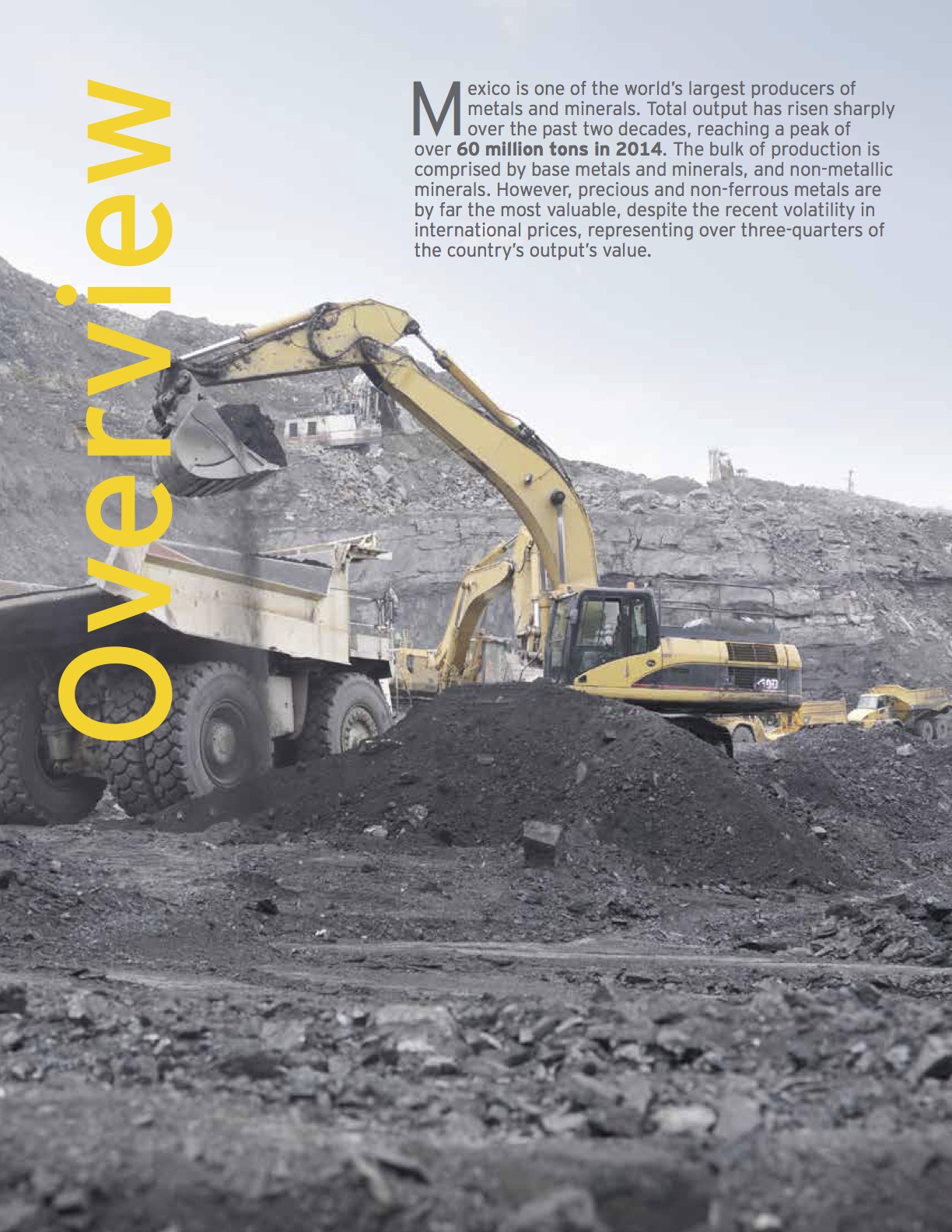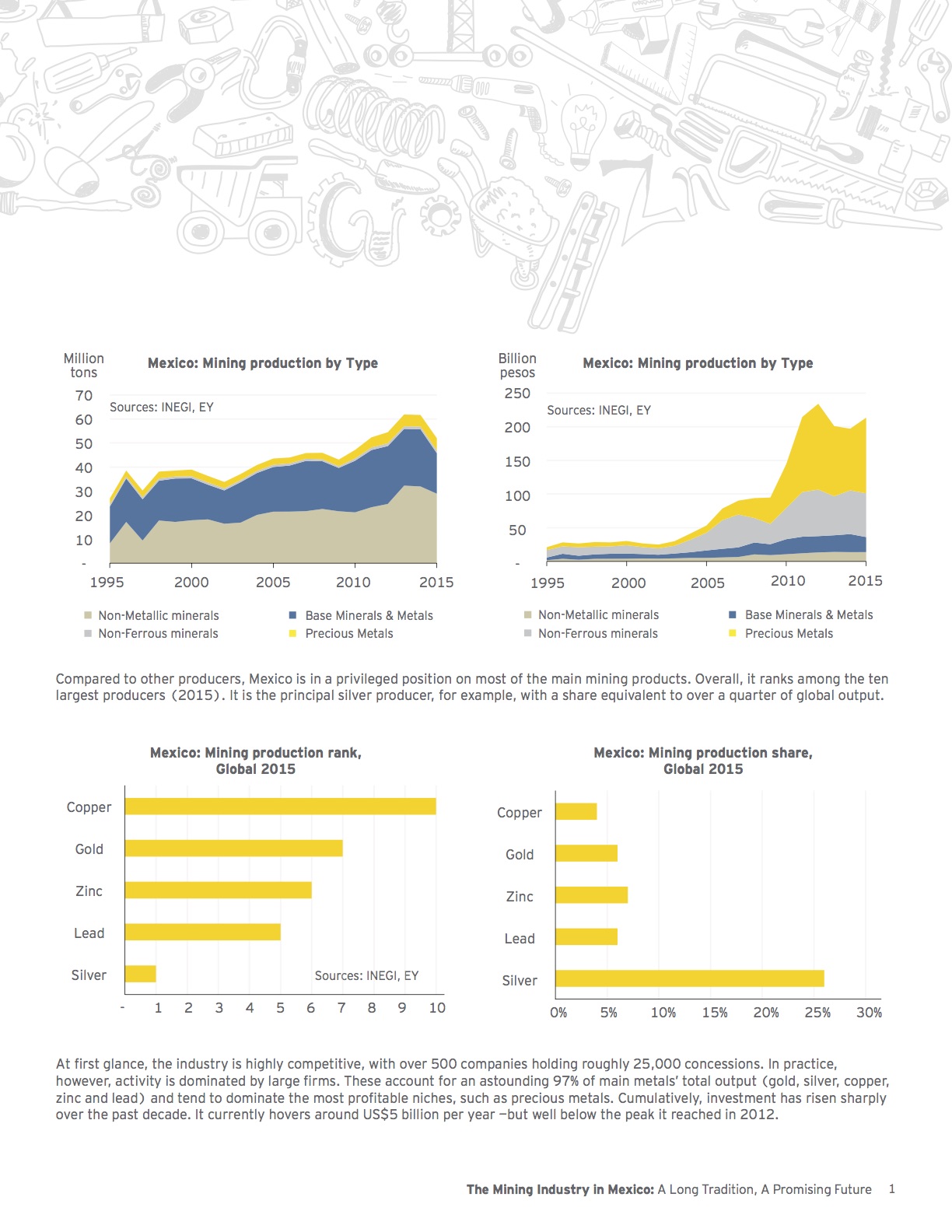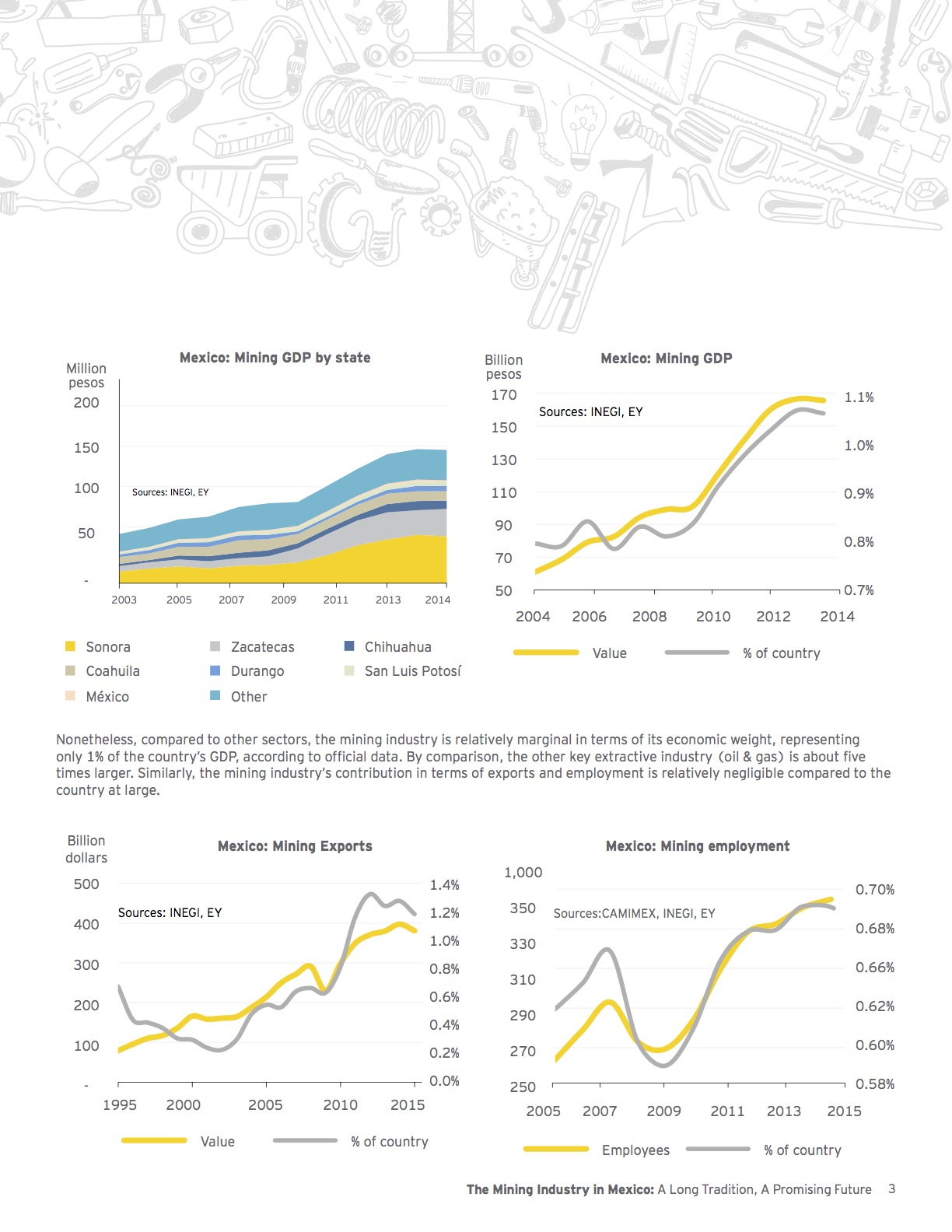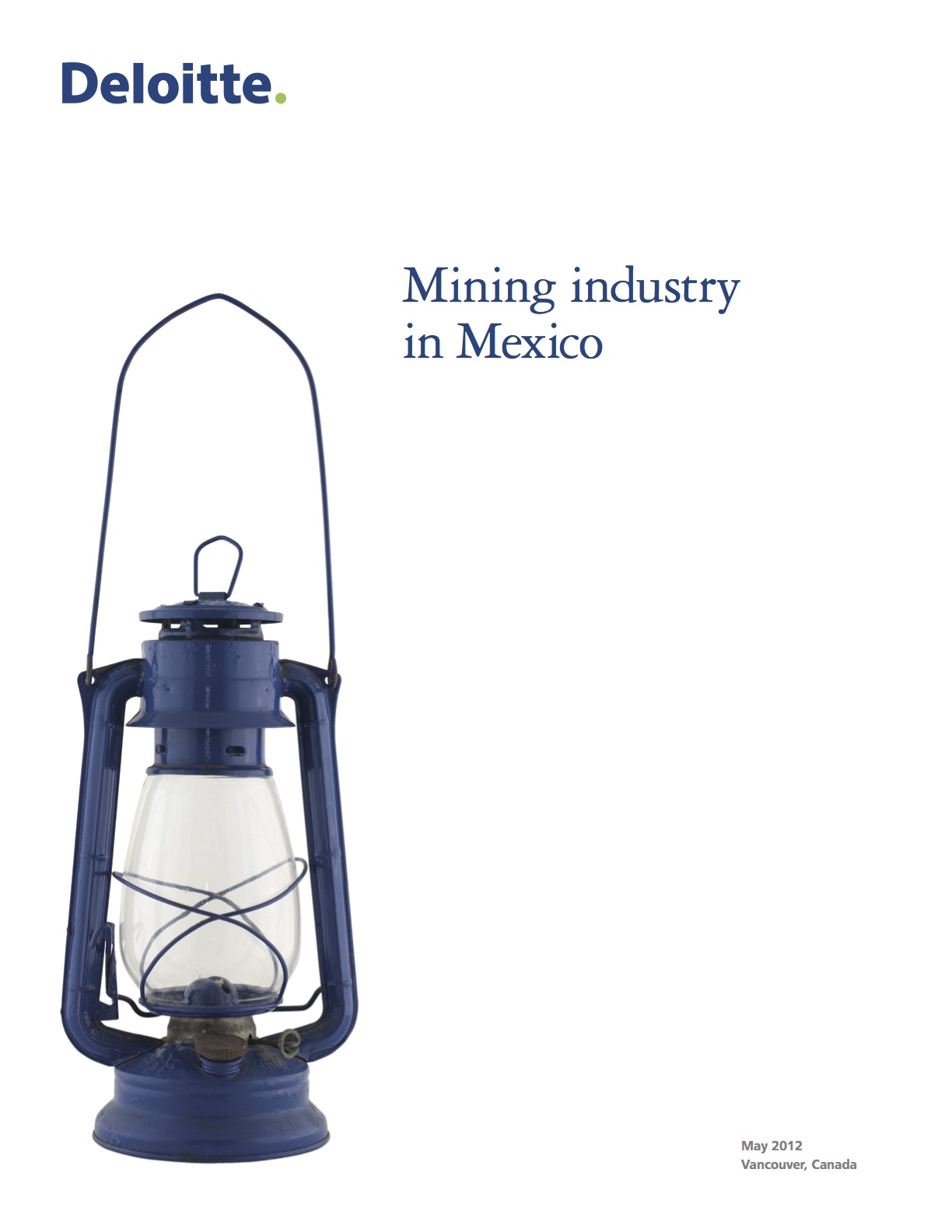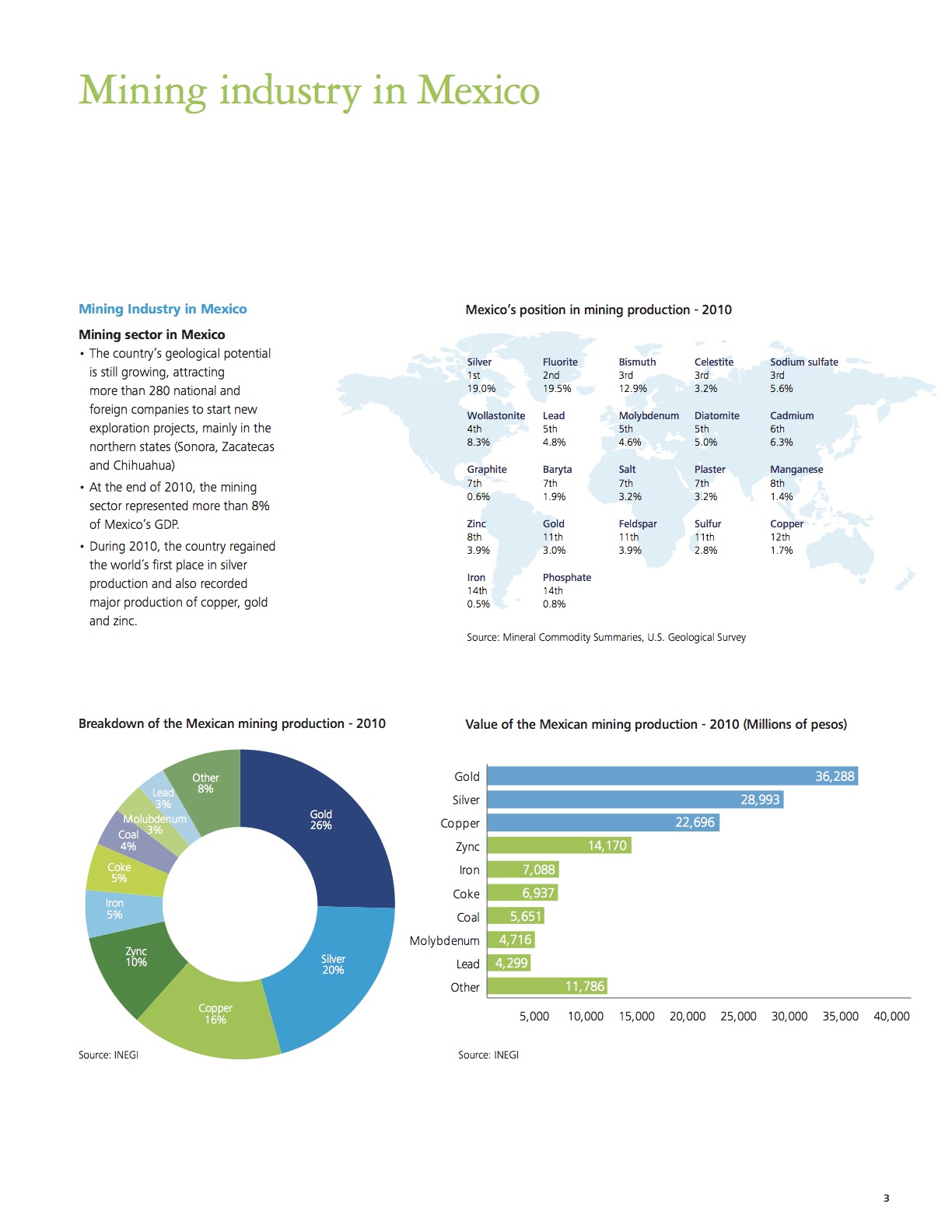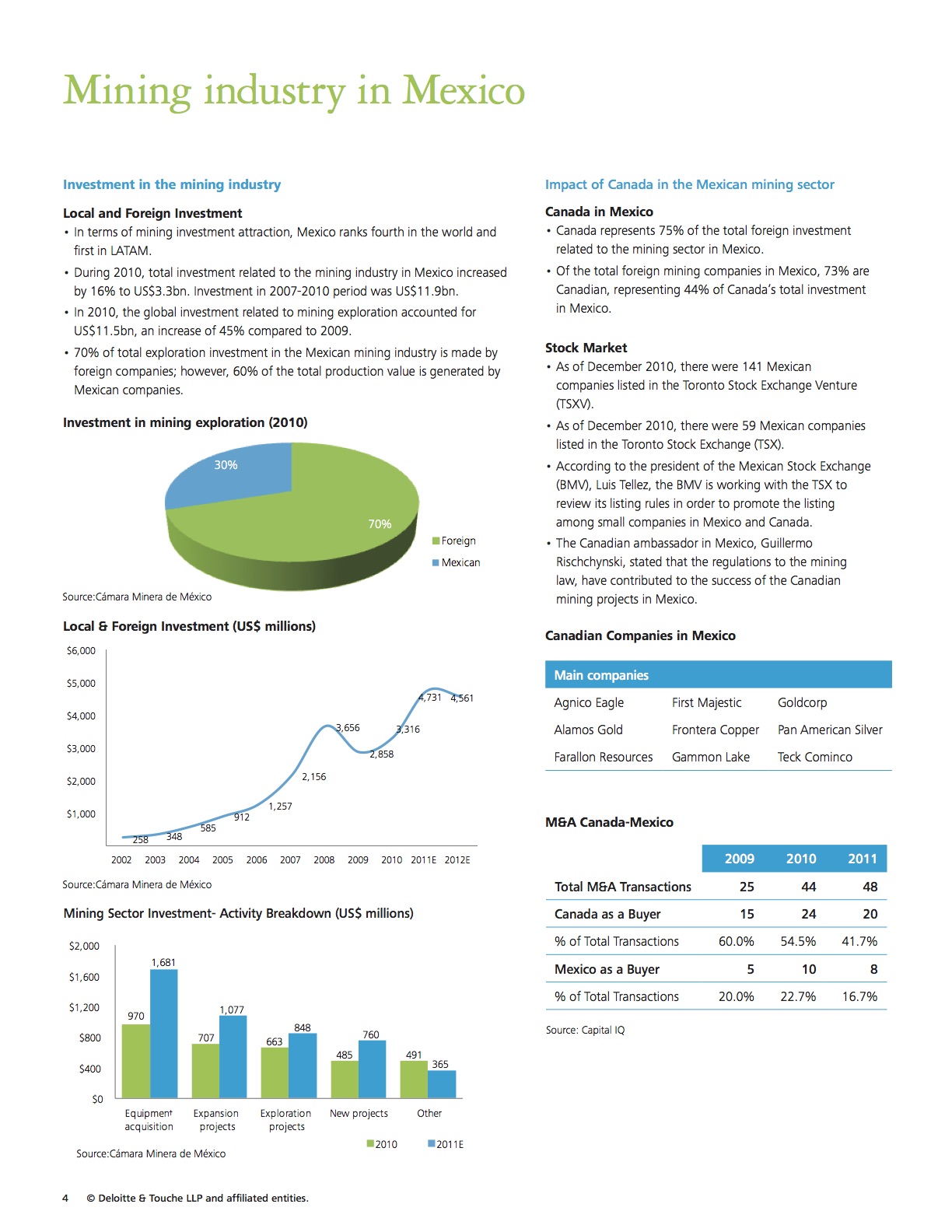The following infographic breaks down everything you need to about the metal.The future goes through lithium.
The Future of Gold Exploration is Under Cover
Over billions of years, extraordinary amounts of gold and other metals were deposited and spread throughout the Earth’s crust. Humans have been searching for these rich deposits for centuries, and advances in geoscience and technology have helped us become more adept at finding them over time.
However, even with today’s advancements – almost all early-stage prospecting methods are still based on the same key principle: trying to find areas of exposed bedrock, called outcrops, that indicate an orebody is near.
But such outcrops only form in certain circumstances – and what happens when a geological system doesn’t come in contact directly with the surface?
Mining In Mexico: An EY Report
Recently, EY published a brief report on the state of mining in Mexico.
We have distributed it here for your ease and if you have any questions or would like to discuss any of our Mexico activities,, please do not hesitate contact us.
Click here for the full report.
All credit and ownership belongs to Deloitte & Touche LLP and affiliated entities.
Mining In Mexico: A Deloitte Report
Recently, Deloitte published a brief report on the state of mining in Mexico.
We have distributed it here for your ease and if you have any questions or would like to discuss any of our Mexico activities,, please do not hesitate contact us.
Click here for the full report.
All credit and ownership belongs to Deloitte & Touche LLP and affiliated entities.
Visual Capitalist: Project Generators
Visual Capitalist: The Mineral Exploration Roadmap
INFOGRAPHIC: The story of the Golden Triangle in British Columbia
A Revival Takes Shape in BC's Golden Triangle
This is a story about past, present and future in a mineral-rich corner of the North American continent. High-grade gold mines like Snip and Eskay Creek helped give northwestern British Columbia its Golden Triangle moniker. If those two operations are symbolic of the region’s rich past, Red Chris holds a strong claim on the present.
The Imperial Metals (III-T) mine is the latest to go into production. This year Imperial expects to pull out more than 90 million pounds of copper and more than 60,000 ounces of gold from Red Chris, a large copper-gold porphyry deposit.
Red Chris feeds into the government funded Northwest Transmission Line, a 344-km 287-kilovolt power line completed in 2014 at a cost of more than $700 million. Imperial Metals built a 93-km extension to the new power line to feed Red Chris.
So the infrastructure push — the power line, roads and new Hydro projects — in the Golden Triangle is a major reason for present-day optimism about revitalization.
The Golden Triangle’s future?
Bob Quartermain, CEO of Pretium Resources (PVG-T), stands on the cusp of a new golden age in the storied Canadian mining jurisdiction.
Pretium’s Brucejack high-grade underground gold mine is taking shape in rugged mountains 65 kilometres north of Stewart, near the Alaska panhandle. Production at the fully funded mine is pegged for the thirdquarter of next year.
Pretium is building the mine's foundation and April is a critical month, as Quartermain and Pretium march towards a goal of commercial production. Construction of the mill buildings starts this month and the skeleton of Pretium’s transmission line will also begin to take shape.
The mill structure is slated to be finished by the fall so work on the mill — which will process 2,700 tonnes of ore a day — can continue inside through the winter. The mine site is a beehive of activity, with about 700 employees and contractors at work building the permanent camp and bulldozers and backhoes moving earth.
It’s been a long, winding journey from Pretium’s IPO on the Toronto Stock Exchange in December of 2011, the year gold briefly touched US$1,900 an ounce.
“It’s about execution now,” Quartermain said in an interview at the company’s Vancouver offices. Pretium's recent US$130-million financing is the final piece of funding for mine construction. “We’ve issued all the stock that we believe we need to issue for development.”
If Pretium can execute — annual production at the Valley of the Kings is pegged at 500,000 ounces in Years 1-8 — the company will join the ranks of giants.
On its heels are several companies in the area advancing discoveries or reviving historic projects. And in the Golden Triangle, the past is close behind.
Ron Netolitzky’s Skeena Resources (SKE-V) demonstrated that recently with the acquisition of the historic Snip mine from Barrick Gold (ABX-T). Netolitzky’s Delaware Resources discovered Snip in the mid-1980s and was later bought out by Murray Pezim’s Prime Resources after running from under a dollar to $28 a share.
VIDEO: Skeena’s Netolitzky goes back for more high-grade gold at Snip
Snip went on to produce more than a million ounces at average grades of 25 g/t for Cominco and Homestake Mining before closing in 1999 due to low gold prices. Its discovery also sparked a staking rush that revitalized the gold play and paved the path to Eskay Creek.
That mine, another Netolitzky discovery, produced 3.27 million ounces of gold at grades of 49 g/t and 158 million ounces of silver at 2,406 g/t — many multiples of average global precious metal grades.
Netolitzky, Skeena's chairman, and his team believe there are many ounces remaining at Snip, stranded by a declining gold price and the high costs of flying out the concentrate production. The option deal with
Skeena Chairman Ron Netolitsky: an eye for high-grade gold
Barrick gives them a chance to prove it. Major infrastructure upgrades — including roads and the transmission line — have reshaped the landscape, making a Snip restart potentially more attractive.
“If you can give me a deposit that’s running at a third of the ounce (about 10 g/t) in this market at that location, you know, that’s pretty juicy,” Netolitzky says. “But we have to go and confirm that.”
There are also earlier-stage plays with upside in the Golden Triangle, and one of the most promising is Millrock Resources (MRO-V). A new player in the region, Millrock is a prospect generator that built its foundation in Alaska and Sonora, Mexico.
On Dec. 14, Millrock announced it had assembled three major land packages covering roughly 600 square kilometres in the Golden Triangle — Todd Creek, Poly and Oweegee Dome — including two projects adjacent to Pretium’s Brucejack.
Fractured land ownership, a dead venture capital market and a lack of interest in gold exploration plays — until recently — gave Millrock the opportunity to enter the district, CEO Greg Beischer says. He admits he was a bit “surprised” that the opportunity presented itself — and Millrock acted fast.
“I concluded — we’ve got to do this,” Beischer says. “We spent two days in the area, mostly looking at drill core and maps — it was late season, it was snowing — and I could just tell right away this was excellent geology and a great prospect. The problem was this fractured land pattern.”
If the quality of the geological prospects was a bit of a no-brainer, securing and consolidating the three land packages was anything but easy. The deal required nine different agreements with landowners to secure the patchwork of properties and clean up the royalties, Beischer says.
Millrock’s Todd Creek adjoins the southern boundary of Pretium’s Brucejack claim block, while the nearby Poly project is bisected by Highway 37A and power lines. Oweegee Dome is adjacent to the eastern boundary of Brucejack and Seabridge Gold’s KSM property, and is intersected by Highway 37 and the new Northwest Transmission Line.
Some of the properties — such as Todd Creek — didn’t see any work during the last gold bull market in 2010 and 2011, Beischer says: “I don’t think anyone’s actually been on the property since 2008.”
Millrock comes out of the agreement with a premier land portfolio and is now assembling an exploration database from a rough but extensive collection of data. Beischer’s goal is to do a JV deal with a major who would fund the data compilation and analysis in return for a right-of-first refusal arrangement.
“That would be the ideal outcome,” he says. “But we will also consider advancing these projects further with some of our treasury. We think a year of exploration and analysis could greatly enhance the apparent prospectivity, and therefore the deal terms that we can command.”
While there are some “obvious” drill targets, Beischer says Millrock wants to make sure it doesn’t miss even better targets. A summer program could follow.
“Systematic work is the key,” Beischer says. “We have the time, by virtue of our partnerships with the major companies and the fact we’re always making news somewhere. Unlike other pure exploration
Millrock CEO Greg Beisher: "Waling on rocks that no human being has ever seen"
companies, we are not forced by the market to provide immediate success. We don’t live and die by a single project, so we have time to do things right. Discovery of mineral deposits takes sustained effort by a motivated team with a mandate and budget to do thorough, systematic, scientific exploration. We can and will do it that way every time.”
Beischer, who grew up in Toronto and now lives in Alaska, remembers flying over the Golden Triangle while working for Inco early in his career. He remembers being impressed by the glaciers and snow-covered peaks.
“It was high country, and honestly at the time I wasn’t very familiar with working in big mountain country like that,” Beischer says. “When I go back thirty-five years later, a lot of the ice is gone.”
That declining snow cover increases the potential for new discoveries, which works in Millrock’s favour — and all the Golden Triangle exploration and development players.
“In eight years of glacial retreat, at the rate it has been going, there could be an ore body sticking right out of the ground that nobody’s even seen before,” Beischer says. “This summer we’ll be walking on rocks that no human being has ever seen, so you just never know.”
And Millrock is not finished just yet. This morning the company announced further staking that connects the Todd Creek and Poly properties. The new tenures cover 5,391 hectares and allow assessment work credits to be spread over the entire land package.
On March 21, the company had added the LNT (Lord Nelson Tenures) property, which adjoins the Poly property to the south. The expanded Poly property is now situated 34 kilometres northeast of Stewart. The claims were picked up from Geofine Exploration Consulants (GFX), a group with decades of experience in the Golden Triangle that originally optioned the properties from Teuton Resources.
Beischer says his initial introduction to the Golden Triangle came via his friend Rob McLeod, the president and CEO of IDM Mining. McLeod used to work in Alaska for Beischer when the two were with Inco in the late 1990s.
“Rob would rave about the Golden Triangle’s mineral potential,” Beischer says. “Millrock started poking around in 2015. We spoke with Teuton Resources, who have a lot of good properties. But ultimately our current land package is what came out of it.”
McLeod is developing his own highly prospective high-grade gold play in the Golden Triangle: IDM Mining’s (IDM-V) Red Mountain project, near Stewart.
And the past looms rather large there, too. The company is named for Rob’s father Ian McLeod and uncle Don McLeod, gold miners and mine builders of some acclaim (there’s a Valley of the Kings connection through Don McLeod’s Newhawk Gold Mines, which once owned Brucejack). Rob is a third-generation miner — both his father and grandfather were underground gold miners.
McLeod, who grew up in Stewart, had his greatest score in the Yukon, when he sold Underworld’s White Gold discovery to Kinross in 2010 for $139 million. That takeover sparked the biggest staking rush in the territory since the Klondike Gold Rush. McLeod is back exploring in the Yukon after picking up prospector Shawn Ryan’s extensive claims package in a recent deal with Oban Mining.
But IDM’s flagship project remains Red Mountain, which is moving through the permitting process. McLeod actually worked at the project as a young exploration geologist with Lac Minerals.
The plan at Red Mountain is to get a small, rapid-payback mine into production and grow it from there. Building a mine would cost $76 million in capex, thanks in part to historic infrastructure including a production-sized underground ramp.
IDM recently announced some changes to the mine plan — including a lower-elevation tailings facility — that could make it a year-round operation. Under a previous plan, the mine would have shut down during the four months of heaviest snowfall.
“A year from now we expect to begin construction on a mine that could produce more than 100,000 ounces of gold a year, with rapid payback — a year or less — and great exploration upside,” McLeod said.
This morning IDM released an updated resource estimate for Red Mountain that increased Measured and Indicated ounces by 16% and Inferred ounces by 31%. At a cutoff grade of 3 g/t, Red Mountain hosts 441,500 ounces of gold at average grades of 8.36 g/t Measured and Indicated, as well as 1,379,800 ounces of silver at 26 g/t Ag. In the Inferred category, there's a further 107,500 gold ounces at 6.1 g/t Au.
The new resource — as well as a weaker Canadian dollar and higher gold prices — will be incorporated into a new preliminary economic assessment expected in Q2 as well as a feasibility study targeted by the end of the year.
As for Pretium’s Brucejack, Quartermain looks forward to a day not far off when the mine and its 500 high-paying jobs revitalizes the region’s economy while spinning off cash for shareholders.
It’s too early to speculate, but Pretium could become a dividend payer, the CEO says.
“Having just turned 60 and Pretium being the largest asset that I own, if it paid a dividend I’d be quite happy about that,” Quartermain says.
He said it with a smile, but I don’t think he was joking.
James Kwantes
DISCLAIMER: Author owns shares of Skeena Resources. The work included in this article is based on SEDAR filings, current events, interviews, and corporate press releases. It may contain errors, and you shouldn’t make any investment decision based solely on what you read here. This publication contains forward-looking statements, including but not limited to comments regarding predictions and projections. Forward-looking statements address future events and conditions and therefore involve inherent risks and uncertainties. Actual results may differ materially from those currently anticipated in such statements. The views expressed in this publication and on the CEO.CA website do not necessarily reflect the views of Pacific Website Company Inc., publisher of CEO.CA. Pacific Website Company Inc. provides advertising and multimedia creation services to Skeena Resources and Millrock Resources, which makes CEO.CA biased in its coverage of those companies. This publication is provided for informational and entertainment purposes only and is not a recommendation to buy or sell any security. Always thoroughly do your own due diligence and talk to a licensed investment adviser prior to making any investment decisions. Junior resource companies can easily lose 100% of their value so read company profiles on www.SEDAR.com for important risk disclosures. It’s your money and your responsibility.




